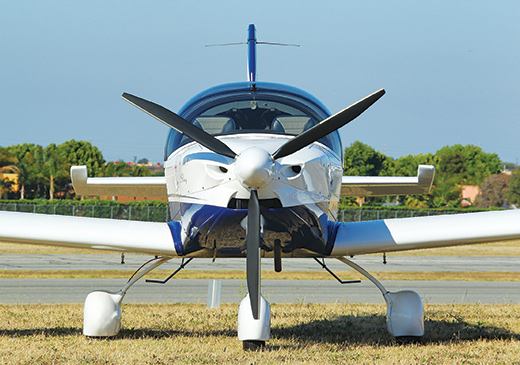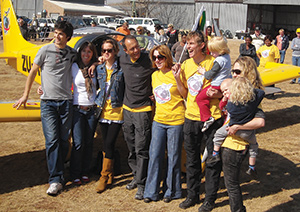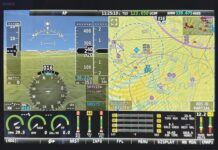
Eight years into the Light Sport Aircraft experiment, we’re seeing what could be significant signs of maturity. In the beginning, many new designs arrived, jockeying for position in what was hyped as a soon-to-be-crowded market. Rushing to the front of the queue, some manufacturers cobbled together designs from European microlights, boosting the maximum gross weight to, or close to, the new LSA limit. Still other designs came from the other direction, downsized Experimental/Amateur-Built aircraft nipped and trimmed to get under the arbitrary 1320-pound weight limit, otherwise neutered to stay within the various top- and stall-speed limitations.

Matt Liknaitzky heads up U.S. distribution of the Sling, based at the Torrance, California, airport.
Eventually, of course, pure designs emerged, aircraft penned with the specific limitations of the LSA category in mind, crafted to take best advantage of what little real estate remained inside the LSA box. Aircraft such as the RANS S-19 and Van’s RV-12 and Zenith CH 650—along with a number of aircraft sold strictly as ready-to-fly LSAs—came to exemplify the “standard” low-wing, side-by-side, bubble-canopy look of the modern LSA.
Add another to the list in the Sling 2, a design hailing from Johannesburg, South Africa. It benefits from timing: The company fully understood the LSA limitations and watched carefully as other designers struggled with them. In turn, the Sling, built by The Airplane Factory as both a kitbuilt and ready-to-go SLSA, carries design precepts that help set it apart from its competition.

Speed Deed
For one thing, because the company recognizes the performance limitations of LSA, it has purposely made the cabin quite large given the overall weight and size of the airplane, and the anticipated installed power. Designer Mike Blyth understood that the performance limitations within LSA would set an upper limit for speed, and that a reasonably clean aircraft could easily increase cabin size and tail volume (and embrace other features) while still maintaining competitive performance.
To that end, TAF claims a 75%-power cruise of 115 knots true airspeed (KTAS), comfortably under the airframe’s 135 KIAS Vne. It’s interesting to note that the “unrestricted,” non-LSA version of the design—one that can go to 1540 pounds maximum gross weight, against the LSA limit of 1320—is slightly slower. What that says is the design is optimized for the 115 KTAS cruise speed on the normal 100-horsepower Rotax 912S. The company will also soon begin testing, and eventually will offer, the option of the turbocharged Rotax 914 (115 hp for takeoff, 100 max-continuous); purported performance is 118 KTAS at 6000 feet, though you should expect better speeds at altitude. If the turbo Sling could maintain the same indicated airspeed at 12,000 feet as it does at 6000—again, purely hypothetical until we get a chance to actually fly one—it should run 130 KTAS. It might even do 140 KTAS while still in VFR airspace. (This is for the non-LSA version, of course, since you can’t legally fly an LSA above 10,000 feet except in the vicinity of very high terrain.)
In other respects, the Sling 2’s performance is in line with other LSA. Listed max climb is 900 fpm at sea level; clean stall speed is at the 45-knot limit by 1 knot (reducing to 40 knots calibrated airspeed with full flaps); takeoff and landing distances are 550 and 350 feet, respectively. It’s clear that there are no magic bullets for stall performance, though; the Sling 2’s 127.5 square feet of wing area is almost identical to the RANS S-19’s and the Van’s RV-12’s. Regardless of which airfoil you’re using, it seems that’s how much wing area you need to achieve the LSA rule’s 45 KCAS clean stall speed.

In profile, the Sling appears to be just another modern LSA. That’s before you sample its exceptional handling qualities.
Conventionally Built
Reflecting the new orthodoxy, the Sling 2 is almost completely aluminum, using traditionally formed components and blind rivets to speed assembly. Unlike the RV-12, the Sling uses match-hole tooling punched slightly under size. (The RV-12’s punched holes are final size.) The procedure is to bring the components together and assemble with Cleco temporary fasteners. Drill the holes to final size—typically 1/8 inch—for the structural-grade pull rivets. These holes have to be dressed and deburred, of course, but that’s a standard process on most aluminum homebuilts. Fiberglass panels are limited to the cowling and various fairings; again, this is a very conventional approach to light-aircraft design.

Comfortable chairs for pilot and passenger: The Sling 2’s broad cabin will accommodate even plus-sized Americans.

Behind the passengers is an ample baggage bay. Note the finished interior pieces; no zinc chromate in view.
What’s interesting in the Sling is the level of prefabrication. All control surfaces are basically done, with only minor work required by the builder. The integral fuel tanks are finished and proof-sealed, and any of the major structural components in the wing and fuselage that require driven rivets are completed by the factory. In essence, there are no quickbuild options because the basic airframe is already in that configuration.
Emphasis on Handling
Blyth and U.S. importer Matt Liknaitzky echo the defining terms of the airplane. “We really wanted it to be a great-handling airplane,” Liknaitzky said. “We know there’s plenty of competition, and LSA rules clump performance together, so we wanted it to be something special from the handling perspective.” Liknaitzky said that a tremendous amount of development work took place in South Africa to fine-tune the Sling’s responses; surface sizes, control gearing, ergonomics and myriad other detail tweaks helped make the Sling handle more like a larger airplane. This emphasis underpins the company’s belief that many of its customers will be coming from conventional aircraft, with more standardized handling qualities and more heft, which tends to take the “skitter” out of light aircraft. The early accident record of LSA suggests that light controls, low wing loading and, perhaps, pilot training were all factors in the high number of takeoff and landing incidents.

Resplendent in its ubiquity, the Rotax 912S is the standard engine for the Sling. The company is looking at the turbocharged 914 and the injected 912 iS as well.
With an incident-free flight on my agenda, I joined Liknaitzky at The Airplane Factory’s U.S. base in Torrance, California, for a flight in the factory Sling 2. This particular airframe used the Rotax 912S and a Warp Drive three-blade, ground-adjustable prop. As mentioned, TAF is working on a 914 installation as well as one with the new fuel-injected Rotax 912iS; the development takes place in South Africa, so there were no skunkworks to be seen.

The Sling’s “squinty eyed” cowling reflects a desire to reduce cooling drag. The radiator has its own scoop below the spinner; upper inlets feed the airbox and cylinder baffles.
On a typically lovely California day, Liknaitzky and I taxied out in the Sling. Preflight and startup duties are totally routine for a Rotax-powered LSA, though he did take the time to show me the well for the ballistic full-airframe parachute—the supporting cables run under the fuselage skin beneath the sliding canopy’s rails to a well against the firewall; when the ’chute is deployed, these cables rip through the thin aluminum skin and support the airplane from the firewall and the strengthened roll-over structure behind the pilots’ heads.
Fuel comes from two unusually large fuel tanks, carrying a total of 39.6 gallons. (The odd number comes after the conversion from liters, which is 150.) Most LSA in this category offer about half the capacity. When you fill the tanks, the 912S-powered Sling ought to fly for 7.5 hours with a full hour’s reserve! In the LSA version, you’d have to be solo or one of two very light pilots to carry that much fuel, though; TAF lists a basic empty weight of 815 pounds. That’s 505 pounds total payload, 232 pounds of which is the full lot of fuel, leaving 273 pounds for the cabin.

For our flight, we were a bit more than half full (approximately 11 gallons per side), which gives a comparable cabin load to most LSA in this class when they’re full. In the Sling, you can choose to operate either tank individually or in “Both” mode, which is somewhat unusual for a low-wing design. That fuel selector takes center stage on a composite strut beneath the main instrument panel. Behind it are controls for the throttle and brakes. Manufacturers can choose from a directly steered nosewheel and a single brake, or a free-castering nosewheel with individual brakes; TAF chose the former. It works fine, too; the gearing on the pedals results in low foot effort, but the steering is not too touchy. With just a bit of practice, you can track the taxi line without thinking much about it. Same with the hand brake, which really can’t be manipulated with the throttle at or near idle. Fortunately, the Sling I flew had enough idle-speed thrust that the control could stay at idle, leaving your right hand free to work the brake lever.

That’s throttle on the left and brake on the right—pull aft to engage. The arrangement seems like it would be awkward, but it works fine in practice.
Shiny Boxes
Because the U.S. arm of TAF is also an MGL Avionics distributor, it was no surprise to see MGL boxes on the panel. Liknaitzky and I worked from the checklist stored in memory. Wrapped up with the pre-takeoff checks, I slid the Sling onto the longer of Torrance’s (KTOA) two parallel runways, dropped about one-third flaps and let ’er rip. Initial acceleration is fine, probably a bit more gradual than the lighter RV-12 but on par with the RANS S-19.

Twin MGL Avionics EFISes bracket basic analog gauges and the radio stack. Soon, the Sling will be available with MGL’s touchscreen devices and remote radios.
Recommended rotation speed is 45 KIAS, which comes quickly enough; the Sling shows no tendency to do a dance on the gear at this speed. Moderate backpressure brings the long nose onto the horizon and the Sling steps off the runway smartly. We flew with a 15-knot wind running 45° off the runway heading. An airplane with good rudder/nosewheel calibration requires relatively little extra rudder once the wheel is off the ground. The Sling scored well here: As soon as the wheel was off, the nose jinked slightly left (the wind was from our left), but it was a movement easily and naturally fixed with a touch more rudder input. This ratio is hard to peg in the design phase, but the Sling did very well.

A conventional slider canopy provides the expected visibility. A small sunshade provides a measure of SPF.
With the prominent proboscis on the horizon, just below the field of view, the Sling, now flaps up, accelerated to 85 KIAS and maintained a healthy 700-750 fpm. Best rate of climb is 75 KIAS, so the factory’s claim certainly seems in the ballpark. Temperatures and pressures looked good, with the Rotax’s CHTs running in the low 200s and oil temp at 165°. The outside air temp was 74°.
During the initial climb, the Sling’s really pleasant handling qualities start to make themselves known. The ailerons are lighter than the elevator, which is lighter than the rudder effort. Making a minor change in bank angle requires little sideways pressure, but the effort/response coupling is very natural. Pitch is heavier, and I noticed it required almost no thought to peg and hold a desired airspeed. Looking at the in-cockpit video, it’s clear the airplane has sufficient yaw stability. From the camera’s perspective behind the pilots, it can sometimes look as though the fin is hardly working, but in the Sling, the yaw motions are mild and quite obviously damped quickly. (The pilots actually feel a bit less of this motion, sitting as they are very near the center of lift.)

Cruise Time
We leveled off at 5000 feet MSL, density altitude of 7400, and let the airplane accelerate. With 5500 rpm showing, the indicated airspeed wraps up to 106 KIAS. A two-way GPS run confirmed the resulting 118 KTAS cruise figure; the onboard fuel totalizer read just under 4 gph. Run that through your calculator to find fuel economy near 34 statute miles per gallon.
One delight of this design is the roll control in cruise. Often, finding the right balance between good forces and stability at low speed and high is difficult, with some airplanes too skittish at low speeds or with too-high forces with increased airspeed; the Sling finds the sweet spot. Moreover, it’s done in a way that makes the airplane seem intuitive to fly. Specifically, the on-center response to the stick is relatively numb, so that inadvertent movement of the stick doesn’t readily displace the airplane. But as stick deflection increases, the airplane begins to respond more aggressively.

Upturned wingtips help improve efficiency.
In all the maneuvers we tried, the Sling responded predictably. Stalls provide a lot of aerodynamic warning—probably not as much as the RANS S-19, which shudders like a wet dog, but more than the RV-12 and a whole lot more than many conventional homebuilts. Pitch stability is consistently positive, at both cruise and maneuvering speeds. Displace the airplane from cruise speed and release the stick: It quickly heads toward a restorative pitch attitude, bottoms out of the first correction cycle in 3-4 seconds and begins a mild overshoot. It reverts to trimmed airspeed in fewer than three cycles. The only difference at maneuvering speed is that the Sling responds slightly slower, but the indications of positive pitch stability remain.

Landing lights, where they belong: on the wing, not below the engine.
This is not to say the Sling is stiff and overly stable. In fact, it’s so pleasant to fly that you won’t want to be straight and level for long. Roll rate is very good, easily on par with the flaperon-equipped RV-12, and roll responses are so natural that you seldom overshoot the desired bank angle, even when going from 45° one way to 45° the other. Through all that, the airplane is sufficiently pitch stable that the nose stays put and the VSI barely has a chance to react before the maneuver is over.

Effectively large ailerons help give the Sling 2 superlative feel and responsiveness in roll. All axes are well balanced.

The Sling design has ample vertical-fin area for strong yaw stability, while retaining ideal rudder forces.
It’s a bit of a cliché that pilots love airplanes that flatter their landing skills, but as every cliché is slightly based in fact, the Sling ought to find admirers. It holds the desired 75 KIAS final approach speed well—this is higher than you’d expect, but a good starting point until you’re comfortable with the airplane—and offers a magnificent view over the nose. With full flaps, it’s just draggy enough that an approach begun too close to the airport and too high can be salvaged with idle throttle and a bit of a slip. (Try it with an RV-12, and you’ll float down the runway, looking like a rube.) Power out nearing the threshold, the Sling settles comfortably with the nose just below the horizon. You can feel ground effect slowing the descent rate and then, right when you expect it, it dribbles down onto the runway. They’ll call you Chuck Yeager.

Avex pull rivets make up all of the builder-completed structure. An OAT probe hides in the cabin-air vent.
Dollar Days
In all, the Sling 2 is a delightful flying experience. It’s also priced to be competitive with its primary rivals. The Airplane Factory gives an all-up price for the kitbuilt of $66,685, which includes the entire kit, engine, prop, interior, electrical items and avionics. Van’s lists the RV-12 as $64,165. Based on our understanding of the options list for the RANS S-19, it’s similarly priced. Differences in options, available avionics and other factors make it difficult to make direct apples-to-apples comparisons, but it’s fair to say these three airplanes are within a vacation to Cedar Rapids in total cost.
Maturity and competition in the LSA market has been a good thing. Newer designs, those penned just for the class, have formed into a group of well-understood, fairly conventional aircraft suited to the limitations cast in stone. The Sling 2 is arguably the latest and overall best handling of that new breed.

The maingear wear 15×6.00 tires, which are only slightly smaller than a typical trainer’s 6.00×6 doughnuts.

For more information, call 310-721-9190, or visit www.airplanefactory.com.
















This article must be a regurgitation from a long ago story as much of what you wrote is quite different than your article would suggest. How do I know? I’m building a Sling 2 taildragger with a 914 Rotax. Real price:. Approximately 67k for quick build kit, 29k for the engine and 20k+ for avionics. (If I remember right, the interior fixings was about 7k)… It should be a good performer when completed.
Yes, this article was published in 2012.